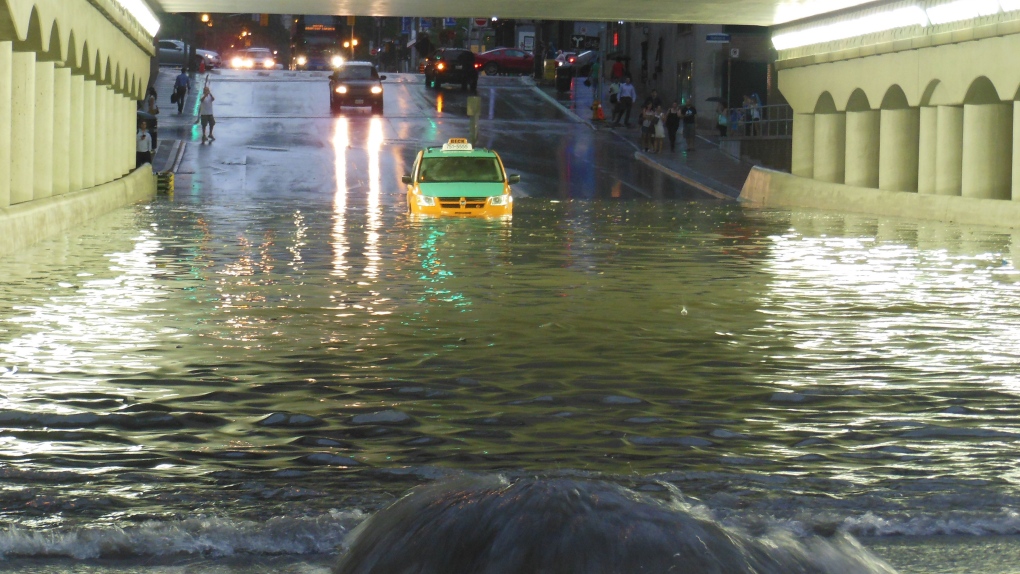
Storm water is the result of snowmelt and/or rainfall that flows on the surface of land and into sewage (storm water pipes) or natural systems. Other activities such as car washing and lawn watering can also impact storm water infrastructure [1]. In the event of heavy rainfall, urban flooding can occur when smaller rivers, streams, and sewage systems exceed their carrying capacity due to urban runoff which, differs from riverine flooding that occurs when a river exceeds its banks. In urban locations, natural catchments have been significantly altered further impacting the rate of flow and volume of water entering natural and sewage systems during a storm [2]. When storms occur and sewage systems are flooded, the result can be basement and road flooding due to the back-up of urban drainage systems. In order to mitigate this type of flooding, cities and towns have built storm water facilities that can store water for approximately 24 to 48 hours before slowly releasing the water back into sewage or natural systems.
Storm water infrastructure is designed to retain excess water for a short period of time (24-48 hours). During a rain event, once water reaches the designed minimum level, the pond will slowly release water back into sewage and natural systems at a controlled rate even if the storm is ongoing. In heavy rain events, an emergency spillway can be used to prevent a rapid rise in pond levels. Storm water facilities can include retention ponds typically located in communities next to sewage and drainage systems (sometimes called ‘wet ponds’).
Other storm water tools include; bio-retention where vegetation can retain and filter flood water at a slower pace and porous pavement than can slow down the rate of urban runoff entering our natural and sewage systems [3].
Yes, storm water infrastructure has an extensive history throughout the Province of Alberta. For example, the City of Calgary first built systems separating storm water from waste water systems in 1920. Today, the City of Calgary is working on sustainable alternatives to storm water management and techniques to reduce sediment and debris from entering storm water systems [4].
The City of Edmonton has also implemented innovative storm water techniques aimed at reducing urban runoff, including; bio-retention and rain gardens to utilize water-retaining vegetation, green roofs, rainwater harvesting for re-use, permeable pavement, and bioswales that use vegetation to direct storm water [5].
Storm water infrastructure is a cost effective flood mitigation option that retains excess water in times of flooding or storm water surges. Construction costs vary depending on size, type of infrastructure, and landscaping requirements, therefore, it is difficult to discern a specific cost. Depending on the type of storm water facility, maintenance requires unclogging sediment and removing overgrowth.
In Alberta, municipalities use property taxes, development and service charges, borrowing schemes and grants to fund storm water projects. A recent AUMA report highlighted the fact that municipalities and operators noted a shortfall of funding between $100,000 and $100,000,000 for storm water infrastructure projects and maintenance [6].
Dry detention ponds and wet ponds can take anywhere from 3 to 6 months to build, depending on size, type of infrastructure, and the surrounding landscape [7]. Similarly, system separation, bio-retention, bi-swales, rain gardens, permeable pavement and green roofs can also take months to build depending on size and materials used.
Once built, storm water infrastructure is intended to protect urban areas from flooding. Harder infrastructure options such a wet ponds are more costly to build and require more maintenance over-time compared to softer, more natural options. Storm water facilities built with natural vegetation such as green roofs, bio swales and rain gardens require less maintenance and are expected to last well into the future.
Risks of building and maintaining storm water infrastructure are related to challenges with public acceptance and knowledge, limited financial resources and investment, and urban growth pressures [8]. Additionally, maintaining storm water infrastructure after a flood event requires money and manpower to rebuild and improve capacity. Finding these resources can be difficult. Nonetheless, urban areas are more at risk of flooding and high damage costs if storm water facilities are not built.
The most significant impact of storm water flooding is sediment loading that occurs after a rain storm or snow melt event. Sediment is picked up from roads, lawns, roofs and a variety of other sites then carried to local watersheds where rivers and streams can become polluted. It is important to note that run-off causing turbidity is impacted by water volumes, rates of runoff and potential erosion. As a result, aquatic species such as fish are impacted due to water pollution and compromised water quality that increases disease and makes finding food or spawning grounds more difficult [9].
Other environmental and watershed impacts of storm water flooding include; water quality degradation, impacts to soil moisture and groundwater recharge, and erosion [10]. To address the environmental issues related to storm water flooding, municipalities are educating the public to increase awareness of their actions that contribute to polluting our rivers and streams.
In the event of a drought, harder storm water infrastructure such as a dry pond would not be helpful. Wet ponds, however, could provide short-term benefits although water quality would be an issue. Natural options, however, would provide water retention capabilities as well as the slow release of water resources into the surrounding rivers and streams. For this reason, municipalities across Alberta are exploring natural, sustainable storm water management options to address both flood and drought conditions.
Share this Post:
We provide Canadian educational resources on water practices to promote conservation and sustainability. Our team crafts current and relevant content, while encouraging feedback and engagement.
The Canada WaterPortal is a registered charity, #807121876RR0001
We recognize and respect the sovereignty of the Indigenous Peoples and communities on whose land our work takes place.
© 2025 All Rights Reserved.